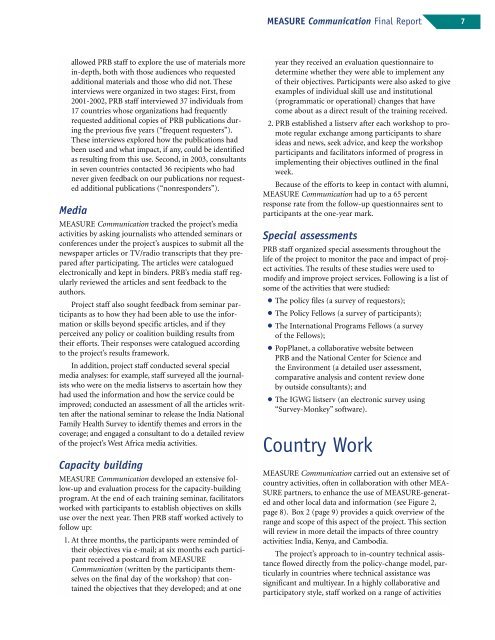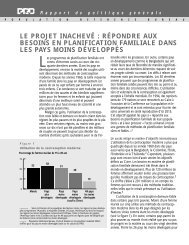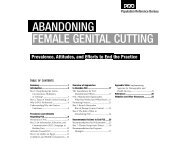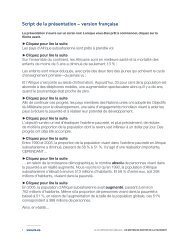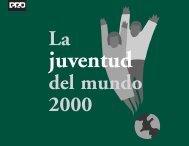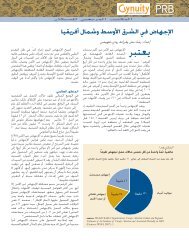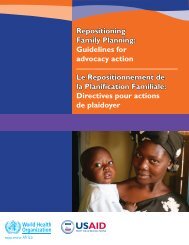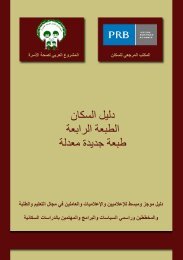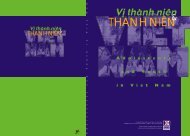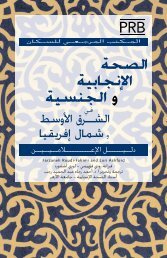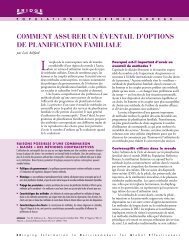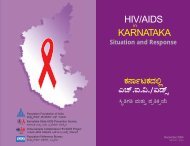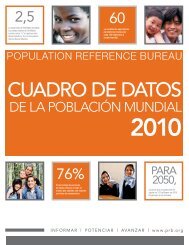MEASURE Communication Final Report - Population Reference ...
MEASURE Communication Final Report - Population Reference ...
MEASURE Communication Final Report - Population Reference ...
You also want an ePaper? Increase the reach of your titles
YUMPU automatically turns print PDFs into web optimized ePapers that Google loves.
<strong>MEASURE</strong> <strong>Communication</strong> <strong>Final</strong> <strong>Report</strong><br />
7<br />
allowed PRB staff to explore the use of materials more<br />
in-depth, both with those audiences who requested<br />
additional materials and those who did not. These<br />
interviews were organized in two stages: First, from<br />
2001-2002, PRB staff interviewed 37 individuals from<br />
17 countries whose organizations had frequently<br />
requested additional copies of PRB publications during<br />
the previous five years (“frequent requesters”).<br />
These interviews explored how the publications had<br />
been used and what impact, if any, could be identified<br />
as resulting from this use. Second, in 2003, consultants<br />
in seven countries contacted 36 recipients who had<br />
never given feedback on our publications nor requested<br />
additional publications (“nonresponders”).<br />
Media<br />
<strong>MEASURE</strong> <strong>Communication</strong> tracked the project’s media<br />
activities by asking journalists who attended seminars or<br />
conferences under the project’s auspices to submit all the<br />
newspaper articles or TV/radio transcripts that they prepared<br />
after participating. The articles were catalogued<br />
electronically and kept in binders. PRB’s media staff regularly<br />
reviewed the articles and sent feedback to the<br />
authors.<br />
Project staff also sought feedback from seminar participants<br />
as to how they had been able to use the information<br />
or skills beyond specific articles, and if they<br />
perceived any policy or coalition building results from<br />
their efforts. Their responses were catalogued according<br />
to the project’s results framework.<br />
In addition, project staff conducted several special<br />
media analyses: for example, staff surveyed all the journalists<br />
who were on the media listservs to ascertain how they<br />
had used the information and how the service could be<br />
improved; conducted an assessment of all the articles written<br />
after the national seminar to release the India National<br />
Family Health Survey to identify themes and errors in the<br />
coverage; and engaged a consultant to do a detailed review<br />
of the project’s West Africa media activities.<br />
Capacity building<br />
<strong>MEASURE</strong> <strong>Communication</strong> developed an extensive follow-up<br />
and evaluation process for the capacity-building<br />
program. At the end of each training seminar, facilitators<br />
worked with participants to establish objectives on skills<br />
use over the next year. Then PRB staff worked actively to<br />
follow up:<br />
1. At three months, the participants were reminded of<br />
their objectives via e-mail; at six months each participant<br />
received a postcard from <strong>MEASURE</strong><br />
<strong>Communication</strong> (written by the participants themselves<br />
on the final day of the workshop) that contained<br />
the objectives that they developed; and at one<br />
year they received an evaluation questionnaire to<br />
determine whether they were able to implement any<br />
of their objectives. Participants were also asked to give<br />
examples of individual skill use and institutional<br />
(programmatic or operational) changes that have<br />
come about as a direct result of the training received.<br />
2. PRB established a listserv after each workshop to promote<br />
regular exchange among participants to share<br />
ideas and news, seek advice, and keep the workshop<br />
participants and facilitators informed of progress in<br />
implementing their objectives outlined in the final<br />
week.<br />
Because of the efforts to keep in contact with alumni,<br />
<strong>MEASURE</strong> <strong>Communication</strong> had up to a 65 percent<br />
response rate from the follow-up questionnaires sent to<br />
participants at the one-year mark.<br />
Special assessments<br />
PRB staff organized special assessments throughout the<br />
life of the project to monitor the pace and impact of project<br />
activities. The results of these studies were used to<br />
modify and improve project services. Following is a list of<br />
some of the activities that were studied:<br />
● The policy files (a survey of requestors);<br />
● The Policy Fellows (a survey of participants);<br />
● The International Programs Fellows (a survey<br />
of the Fellows);<br />
● PopPlanet, a collaborative website between<br />
PRB and the National Center for Science and<br />
the Environment (a detailed user assessment,<br />
comparative analysis and content review done<br />
by outside consultants); and<br />
● The IGWG listserv (an electronic survey using<br />
“Survey-Monkey” software).<br />
Country Work<br />
<strong>MEASURE</strong> <strong>Communication</strong> carried out an extensive set of<br />
country activities, often in collaboration with other MEA-<br />
SURE partners, to enhance the use of <strong>MEASURE</strong>-generated<br />
and other local data and information (see Figure 2,<br />
page 8). Box 2 (page 9) provides a quick overview of the<br />
range and scope of this aspect of the project. This section<br />
will review in more detail the impacts of three country<br />
activities: India, Kenya, and Cambodia.<br />
The project’s approach to in-country technical assistance<br />
flowed directly from the policy-change model, particularly<br />
in countries where technical assistance was<br />
significant and multiyear. In a highly collaborative and<br />
participatory style, staff worked on a range of activities


